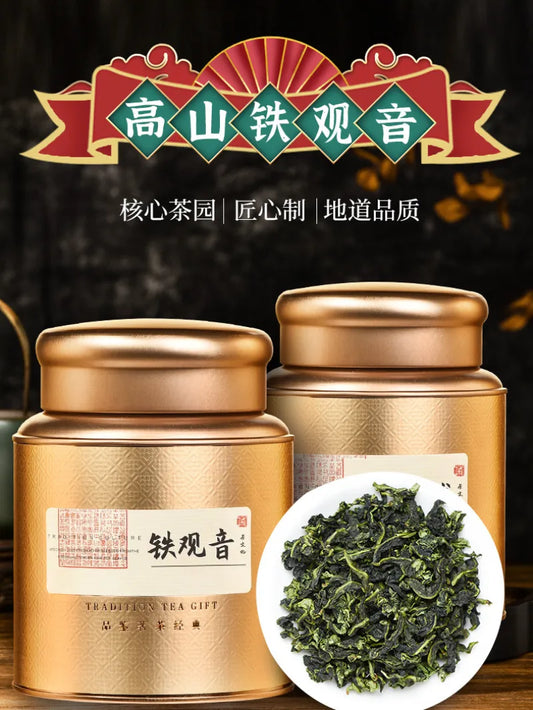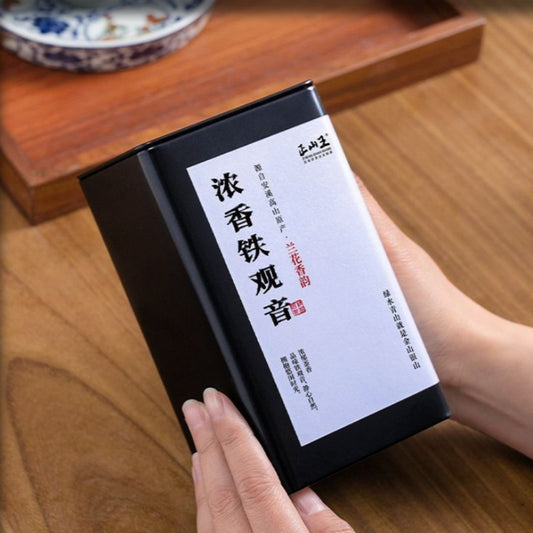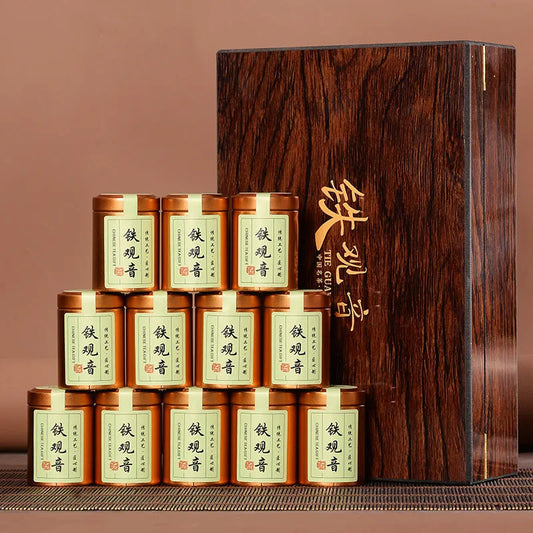Tie Guan Yin: A Millennial Journey Through Fragrant Time
In the misty mountains of Anxi, Fujian, grows a legendary tea that has captivated connoisseurs for centuries—Tie Guan Yin (Iron Goddess of Mercy). As one of China’s Top Ten Famous Teas and a premium oolong tea, it carries over 300 years of tea-making wisdom and cultural heritage. Let us explore the essence of this divine brew and its unique "Guanyin Yun" (Guanyin Rhyme).
I. Legendary Origins: The Tea Named by an Emperor
Tie Guan Yin’s birth is steeped in myth. During the Qing Dynasty, tea farmer Wei Yin prayed daily to Guanyin (the Goddess of Mercy). One night, she appeared in his dream, leading him to a unique tea bush nestled between rocks. Its leaves were thick, glossy, and bore a rust-like sheen. When brewed, the tea was rich, fragrant, and heavy as iron—earning Emperor Qianlong’s praise and the name "Tie Guan Yin" (Iron Goddess of Mercy).
Historically, tea cultivation in Anxi dates back to the Tang Dynasty, but the Tie Guan Yin varietal emerged between 1725–1735. Through generations of refinement, this "heaven-sent tea" became a masterpiece.
II. The Terroir: Where Mountains Meet Mist
Anxi, the birthplace of Tie Guan Yin, boasts a microclimate perfect for tea:
l Xiping Town – The origin, preserving traditional craftsmanship
l Xianghua Village – High-altitude tea with a lingering sweetness
l Gande Town – Modern techniques producing high-aroma tea
l Longjuan Village – Eco-friendly plantations with mellow flavors
Grown at 700–1,000m elevation in iron-rich red soil, nourished by 1,800mm annual rainfall and misty mornings, Tie Guan Yin develops its signature "green leaves with red edges" and "seven infusions of fragrance."
III. Artisanal Craftsmanship: A UNESCO Heritage
Tie Guan Yin is a semi-oxidized (20–40%) oolong, recognized as Intangible Cultural Heritage in 2008. Its production involves 10+ meticulous steps:
1. Plucking – Only "one bud, two leaves" under the afternoon sun
2. Sun Withering – Softens leaves, kickstarts oxidation
3. Indoor Cooling – Balances moisture
4. Shaking & Tossing – Bruises edges, creating "red borders"
5. Fixation – Halts oxidation with high heat
6. Rolling – Shapes leaves and releases juices
7. Roasting – Low-temperature drying for depth
Modern Variations:
l Qingxiang (Light Roast) – Floral, fresh, refrigerated
l Nongxiang (Heavy Roast) – Honeyed, fruity, charcoal-fired
l Chenxiang (Aged) – 5+ years aged, medicinal richness
IV. The Art of Tasting: A Sensory Experience
1. Visual Appraisal
✔ Premium: Tight, heavy pellets; emerald-green with oily sheen
✖ Inferior: Loose, dull, broken leaves
2. Aroma Evolution
l Dry Leaf: Orchid + toasted rice
l Wet Leaf: Milky when hot, honeyed when cool
l Signature Scents:
o Zhengwei (Traditional): Pure orchid
o Xiaoqing (Moderate Oxidation): Gardenia
o Tuosuan (High Oxidation): Sour plum
3. Liquor Color
l Spring Tea: Pale gold
l Autumn Tea: Amber
l Aged Tea: Ruby-red
4. Taste Profile
l First Sip: Bitter → Swift sweetness ("Hui Gan")
l Mouthfeel: Silky, full-bodied ("Velvet Texture")
l Aftertaste: "Guanyin Rhyme"—long-lasting floral finish
5. Spent Leaves
✔ High-Quality: Thick, supple, "red-edged green leaves"
V. Brewing Mastery: Unlocking the Tea’s Soul
1. Teaware: 110ml porcelain gaiwan (best for aroma) / Yixing clay pot (for aged tea)
2. Water: 100°C spring water
3. Dosage: 7–8g (1/3 of vessel)
4. Infusion:
o Rinse (40 sec)
o 1–4 steeps (15 sec +5 sec each)
o Premium leaves last 7–10 brews
5. Serving: "Guan Gong’s Tour" (even pouring) + "Han Xin’s Command" (last drop)
VI. Health & Wellness: Nature’s Elixir
Scientific studies confirm Tie Guan Yin contains:
l Polyphenols (antioxidants)
l L-Theanine (calming)
l Aromatic compounds (mood-enhancing)
When to Drink:
☀ Morning: Light roast for alertness
🕑 Afternoon: Heavy roast for digestion
🌙 Evening: Aged tea for relaxation
⚠ Avoid: Drinking empty stomach or with medication
VII. Cultural Legacy: More Than a Beverage
From Chaozhou Gongfu Tea to Fujian’s daily "Tea-Rice" culture, Tie Guan Yin transcends mere drink. In Anxi, farmers still perform "Calling the Mountain" rituals; overseas, it connects diaspora to roots; in Japanese tea ceremonies, it embodies "Harmony, Respect, Purity, Tranquility."
In 2016, Anxi Tie Guan Yin ranked #1 among Chinese teas, valued at ¥142.4 billion. This cup continues to narrate China’s harmony between man and nature.
"A sip of Tie Guan Yin is like meditation."
As you cradle the golden liquor, inhale its orchid whispers, and savor the lingering sweetness, you partake in a 300-year-old dialogue with the earth. The magic of Tie Guan Yin lies in its eternal ability to surprise—embodying the Zen ideal: "One Meeting, One Lifetime."

![[Tie Guan Yin] Fresh Flora Aroma Oolong Tea Gift Set 250/500g - YIQIN TEA HOUSE | yiqinteahouse.com | oolong tea, tea, tie guan yin](http://yiqinteahouse.com/cdn/shop/products/tie-guan-yin-strong-flora-aroma-oolong-tea-gift-set-250500g-yiqin-tea-house-yiqinteahouse-com-1.png?v=1723259949&width=533)

![Fujian Anxi Premium [Tie Guan Yin] Strong Flora Aroma Oolong Tea 260/520g - YIQIN TEA HOUSE | yiqinteahouse.com | oolong tea, tea, tie guan yin](http://yiqinteahouse.com/cdn/shop/files/6b3ee09b2e6c41a54a825902684384b1.jpg?v=1735736925&width=533)

![Fujian Anxi [Tie Guan Yin] Strong Flora Aroma Small Cannd Gift Box Set 240g - YIQIN TEA HOUSE | yiqinteahouse.com | gift, oolong tea, tea, tie guan yin, tin](http://yiqinteahouse.com/cdn/shop/files/fujian-anxi-tie-guan-yin-strong-flora-aroma-small-cannd-gift-box-set-240g-yiqin-tea-house-yiqinteahouse-com-1.jpg?v=1723262969&width=533)

